Success stories and challenges
On July 26th Lighter Footprints was delighted to welcome 3 subject matter experts from quite different farming backgrounds, but who all ‘live ag’ and are working in different ways for climate action and climate resilience. The three speakers included
- Peter Holding from Holden NSW, and Farmers for Climate Action,
- Jodie Hay, climate advocate, northern Victoria dairy and grain farmer
- Dr Kate Burke, Echuca, Vic and agricultural scientist and farming consultant
The summary below has blue links in bold to the full video presentation chapter points.
You can also:
- Download Peter Holdings’s slideset here
- Download Jodie Hay’s slideset here
- Download Dr Kate Burke’s’s slideset here
- Check out the tweet string with slides and notes
Peter Holding: The importance of economic sustainability to environmental custodianship.
Colin Peace from Jumbuk Agriculture introduces Peter Holding, Community Outreach Officer, Farmers for Climate Action (FCA).
Peter Holding explained that FCA was formed in 2016, with 8,000 farmers as members and 35,000 supporters. FCA advocates for economy-wide emissions reduction, and offers tools to help the transition to low emissions farms. FCA advocates for better climate policy in the conservative political space, especially federally. On his own farm Peter runs merino sheep, grows canola wheat, uses direct drilling, stubble retention for moisture conservation, GPS, time controlled grazing, genetics to improve sheep productivity, and manages risks including opportune planting of particular crops depend on rainfall forecasts.
Food security, farm debt and the importance of government support
What about the future? Food supply is critical to political and social stability. Our supply chains have been lengthened out of producer/consumer control.
Peter showed that on average farm debt is rising (red line) while net income (green line) is falling. Peter expanded on this theme that farming is very much tied to economics, and that incomes fluctuate year to year. Insurance costs are rising and there are some farmers who can’t either access insurance or finance. Without market of government intervention, this has the effect of making action on climate change and other sustainability initiatives inherently difficult ( i.e. improving biodiversity, soil carbon, climate resilience, resilience to drought).
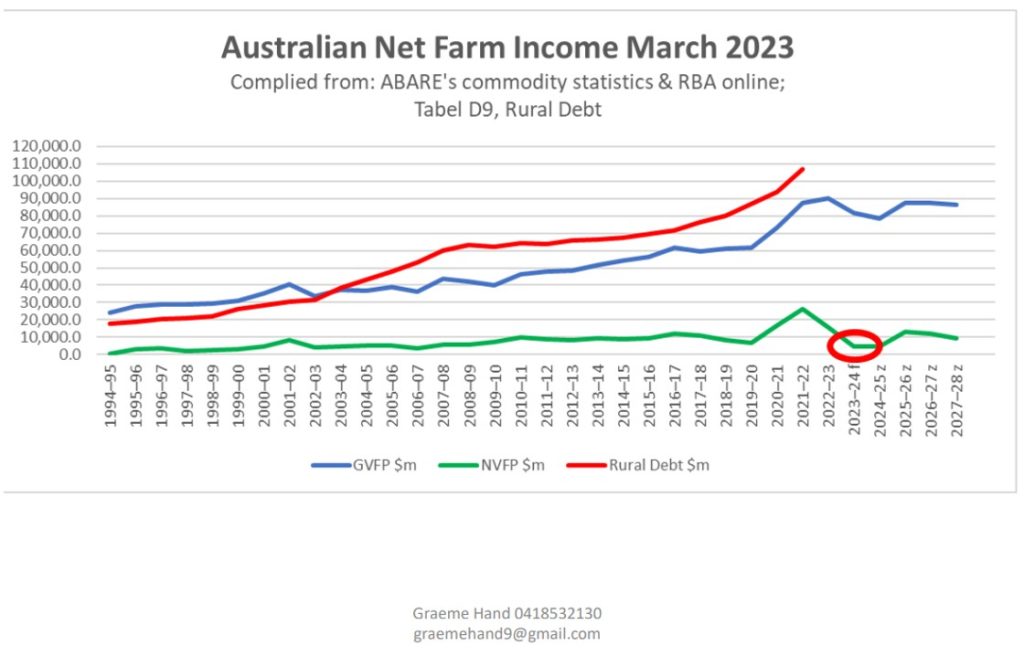
Peter argues that prices for farm produce must reflect the cost of climate action. Increasing soil carbon is challenging in dryland cropping as soil carbon is very much tied to moisture in the ground. It seems that governments and consumers will need to in principle be in partnership to help farmers drive climate action. These realities apply to advocating that big supermarkets do not use an abuse of market power to drive down prices (grain, meat, milk etc) and therefore farm incomes. And government has to be working with farmers as an industry over time to build soil health and build climate resilience, while tackling the drivers of climate change – burning fossil fuels
Transition uncertainies and climate change impacts on the market
Demographic shifts and the rise of corporate profit driven farming chasing profits from shifting cropping to more profitable exotics could lead to shortages of food staples. With climate disasters on top (like recent flooding) you get cascading impacts on markets. There is only a week of food and 21 days of fuel storage in Australia.
Transition uncertainty/costs. A set of farming machines (header, tractor, seeder, sprayer) costs around $2m. Even manufacturers unclear whether future will be electric/biodiesel/fuel cell – leaving resale on redundant machinery as a major risk.
Looking towards the future
Climate change impacts are likely to be quite severe by 2030. Peter Holding reminds us we are all in this together, climate change happening now, here, not overseas. We should combine urban/rural efforts and knowledge. Look for hope, vision, imagination, find allies in working for better policies on emissions reduction, biodiversity repair and more equitable communities.
Farmers for Climate Action have released their Vision and Plan 2022-2024 which includes the comment: “We have led campaigns which have called on political leaders to hasten the transition from
fossil fuels to renewables and ensure rural communities benefit. Farmers for Climate Action has mobilised farmers to demand climate action from their elected representatives”.
Key advocacy highlights of Farmers for Climate Action include:
- Encouraging rural MPs to speak publicly about the opportunities for rural and regional Australia from strong climate policy, including Federal Nationals MP Anne Webster distancing herself from coal and Victorian Nationals Leader Peter Walsh highlighting the critical importance of strong climate policy at FCA events.
- Launching our report “How can Australia’s agriculture sector realise opportunity in a low emissions future?” by Ernst & Young, which found that the sector can achieve net zero emissions by 2040 while increasing productivity and profitability.
Farm debt is rising, up 50% since 2012, now averaging just under a million dollars. Net income has plateaued and insurance costs have risen dramatically Some farmers can no longer get insurance, which means they can’t get finance. He is concerned with demographic changes and rise of corporate farms – concerns include buying in irrigation water for exotic uses, depleting viability of towns e.g. Griffith.
Jodie Hay: Who we are and how we farm sustainably
Introducing Jodie Hay on 1100 hectares, Cohuna, Victoria. Jodie and the Hay family are 3rd generation dairy farmers that have taken on sustainability in their dairy operation as goal to be pursued every day. They have managed to achieve some great outcomes through using this philosophy to inform continuous improvement.
Flexible farming with lessons from the Millenium drought
Jodie Hay talks about water, dairy farming biodiversity and sustainability. She took over 20 years ago in the Millenium drought, had to adapt.
Innovations include:
- Changing from perennial pasture to winter annuals using winter rainfall, summer hay feeding and much less irrigation water.
- Breeding for efficiency – replacement calves enter dairy herd at two years old.
- Large shade barn with a soft floor drops heat 10°C in the summer.
Sustainable farming practices
Primary production farms can be sustainable and offer habitat to many species.
Feeding, welfare and comfort of cows – cows are like other mammals, they need to stay warm in winter and cool in summer. They burn less energy when they are out of the wind and rain in winter, and they thrive when they are not dehydrated in summer. The Hay’s have built an open walled shelter with a concrete floor that is covered with hay that is kept refreshed and clean. The cows clearly prefer to stay warmer and under shelter for long periods in winter, and a little surprisingly avail themselves of the shade for the hottest parts of the day in summer. The shed has a central vent which facilitates good upward ventilation in summer.
Waste management – all the wastewater and wash-down water from the dairy is diverted into a settling pond. This pond does a few things; solids are settled out for later excavation and aeration to become a nutrient-rich top dressing for pasture. The pond and precinct itself is home to up to 60 – 80 species of birds. The water in the pond, is recycled (minus solids) for subsequent use in wash down in the dairy.
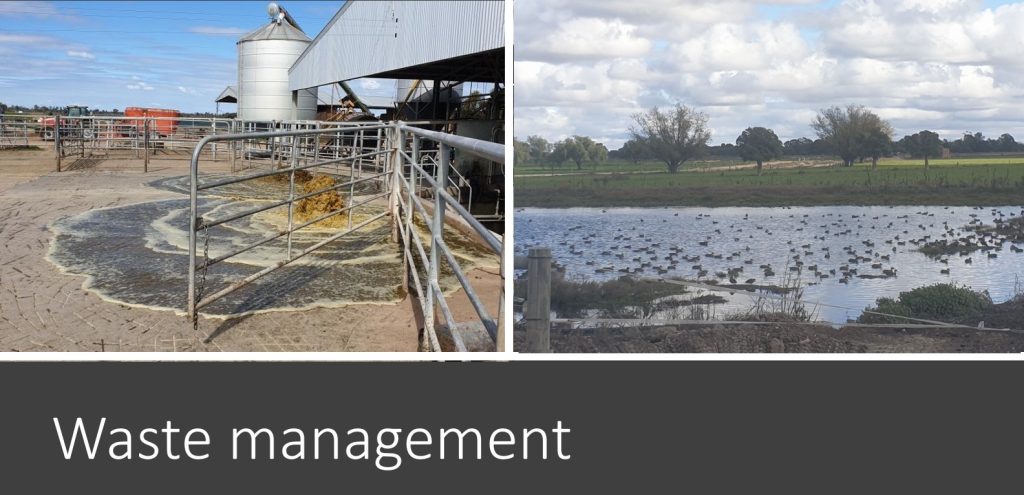
Energy management – a dairy is a reasonably intense electricity user twice a day. The milk from the cows during milking has to be pre-cooled and then refrigerated ready for pick-up by transport. An array of rooftop solar panels on the dairy and shelter provides a significant amount of electricity to their dairy operation. Pre-cooling of milk is done by dropping milk through an evaporative heat-exchange tube and then the 2nd stage involves electric heat pumps to provide the milk refrigeration via a heat exchanger.

Biodiversity – the Hay’s are pushing the boundaries of encouraging biodiversity in planting and nurturing mixed pastures / researching the original woodlands and grasslands and looking at how they can return some land to natural vegetation / providing ground cover on cropping land and /providing habitat for birds in some parts of their property.
Collaboration – it is apparent that Jodie and Colin Hay are life-time learners who aim to collaborate with others and share what they have learned. Jodie is keen to share what she has learnt in their on-farm trials and demonstrated outcomes.

Dr Kate Burke: Dryland agriculture and climate change
Introducing Dr Kate Burke, agricultural scientist, Echuca, with 30 years of consulting on dryland agriculture. Check out Kate’s Think Agri website and her recent book on excellent farming practices.
Dr Kate Burke talked about hope, vision on dryland agriculture and climate change.
Climate variability
Australia is warming up already – we have seen three periods in the last 20 years with above average temperatures in eastern states: 2022-2009, 2012 – 2015, 2017-2022.
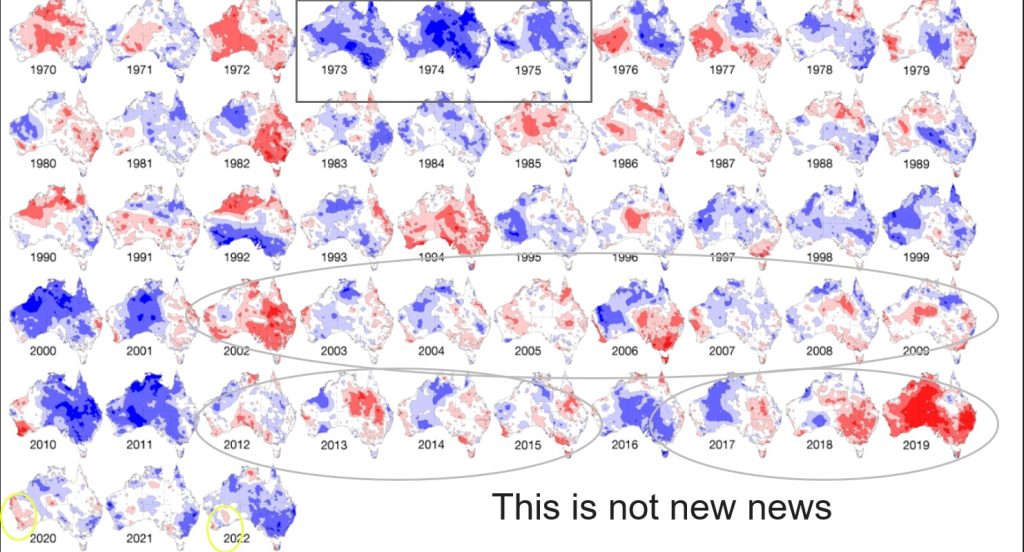
Climate is also influenced by El Nino/La Nina cycles and Indian Ocean Dipole cycles (IOD) – we have seen the Hot and Dry years in 2002, 2006, 2009 and 2015 correspond with El Nino and Positive (or neutral) IOD. While 2019 was neutral between El Nino and La Nina, it was positive IOD and overall climate warming could well be contributing.
The upshot is that we understand more now the interaction between El Nino and IOD, and continue to learn and adapt. Counter to this increased understanding, climate warming from burning fossil fuels is making everything weather events more intense.
Sustainability can go hand in hand with profitability
Agricultural science has a big role to play – we are seeing cattle breeding, and food supplements reduce methane emissions from cattle. Reduced methane emissions (energy emissions) also leads to better weight-gain.
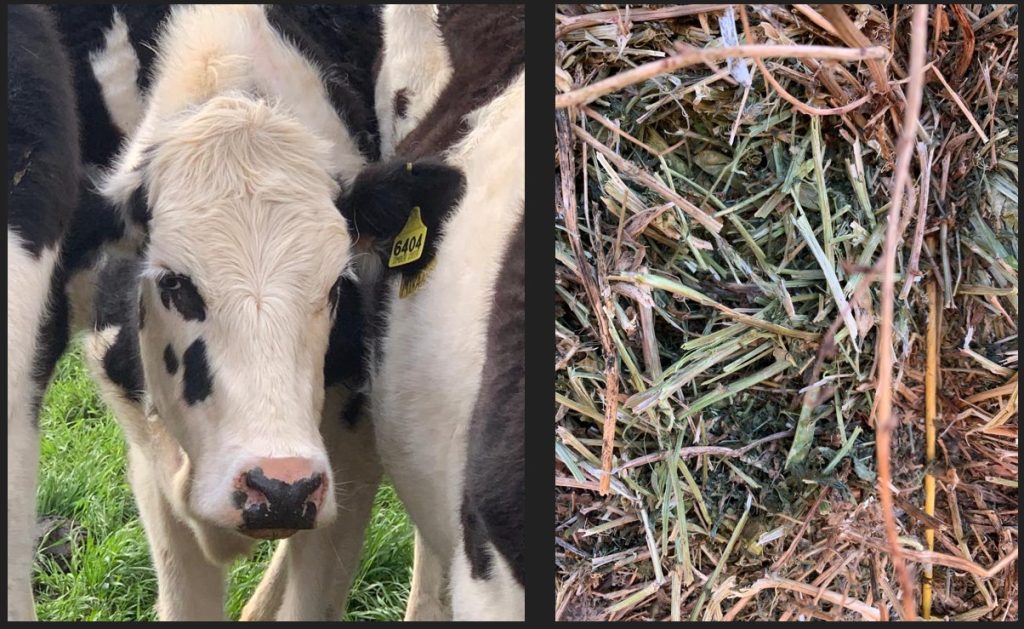
Farming requires a nuanced and sophisticated approach, and climate resilient farms are profitable farms. Weather patterns vary greatly from year to year, which means the pursuit of productive and sustainable landscapes entails the measurement and understanding of what the weather is delivering, and famers adapting their response. For example, good sub-soil moisture carry-over from a wet year in the previous season will provide resilience in the following year to below average rainfall. But the developing El Nino in the 2nd half of 2023 might mean scaling back expectations for success in 2024.
While good soil structure (un-compacted, organic cover) will provide some resilience, using data and forecasts associated with El Nino and Indian Ocean dipole, together with crop behaviour during a season all have to be taken into account. Global warming makes everything harder, which means that transition from fossil fuels towards renewables is key for rural communities to have better opportunities to succeed in landscape management and productivity.
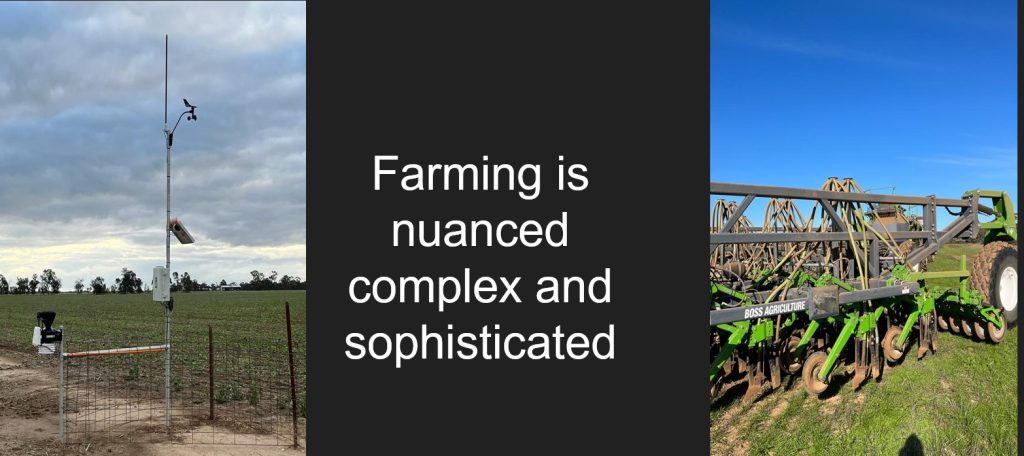
Kate explains the factors driving the potential for increases soil carbon.
Soil carbon hierarchy –
- Soil type
- Climate
- Farm type
- Management
The upshot is that we are hot and dry, and that rural sequestration has very limited potential to offset urban emissions. We must all do our bit to solve the climate crisis including reducing our own emissions at source, however she has hope in the curiosity and innovation of the next generation on the land.
Audience Questions
Question One: GMO crops/glyphosphate
Use of herbicides avoids cultivation for weed suppression which exposes bare soil and increases dustbowl risks
Question Two: Carbon markets/carbon sequestration
Australia has a lower potential for carbon sequestration than North America – no glorious 7% capacity.
With good regenerative practices, including dropping cultivation/burning and increasing ground cover, soil carbon can double (0.8- 0.9 to over 2%). There is interest in carbon markets but if you started after some good years and then your term ended in a drought? Carbon carry capacity related to rain.
Question Three: Replacing nitrate fertilisers with legumes/green manure crops
A lot of pasture is now clovers, lucerne also broad beans.
However there are a variety of reasons why urea is still useful:
- Australian farmers don’t use much nitrogen fertilisers compared to overseas – we don’t have fertiliser subsidies.
- Urea worth $1500/tonne last year, so farmers try and minimise its usage.
- Urea is necessary at times to maximise yeild.
- Global supply chain issues with wheat (Ukraine) means that urea is an important tool for global food security.
Crop diversity spreads risk and return like a share portfolio. Some ‘blue chip’ steady yield, some high risk, high return, some for particular functions like fixing nitrogen. In favourable years we need to feed the crops, in dry years less so.
Question Four: What about seaweed to reduce methane from cows?
Seaweed still in development – looks promising, Jody and Colin Hay use anti-bloat medicine Romancin which also cuts methane 25-37%.
Other local farmers are doing exciting tree restoration projects, working with Murray Darling wetland working group, including planting wildlife corridors. Northern Victorian farmers very conscious of sustainability due to salinity issues from irrigation in 1970s and 80s.
Australian practices of rotating crops, rotating grazing, low or no use of insecticides, lower fertiliser use – similar to regenerative practices in North America like in the “Kiss the Earth” regenerative agriculture movie – moving stock on a fortnightly or weekly basis. However, debt levels on farms often drive what happens – the bank manager comes first.
Landcare helped farmers see change at a landscape level, not just on their own farms. Cell grazing has happened in Australia for at least 35 years. In US 60% of farmers were exposing their soils through cultivation whereas only 20% in Australia.

